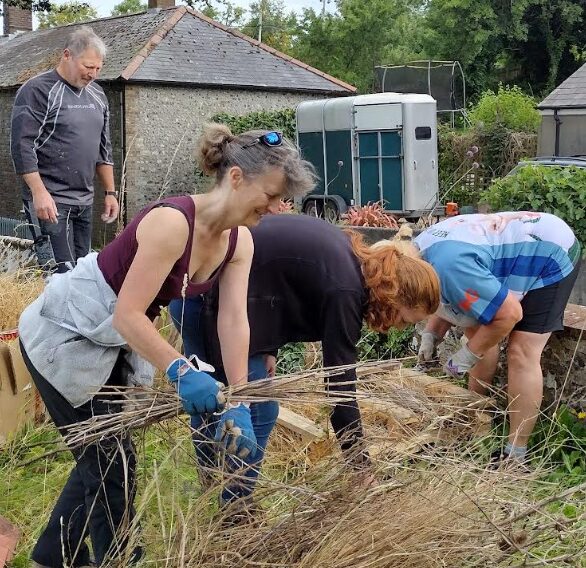Rachael Rowe investigates how Dorset’s living legacy of churchyards blend history, wildlife conservation and community care

There was a time when most people were buried in their local churchyard, with entire generations resting together. Today, 70 per cent of people are cremated, and with pressure on land supply, what is the future for traditional graveyards? Who maintains them and how are the currently-popular rewilding projects managed?
History in graveyards
Cemeteries are steeped in history, and many of Dorset’s churchyards provide the last resting place for notable people, containing a wealth of information for genealogists. Benjamin Jesty, the farmer associated with experiments into immunity from cowpox is buried in Worth Matravers, while the notorious smuggler Roger Ridout rests in comfortable peace in Okeford Fitzpaine.
The Blackmore Vale is also home to many meticulously maintained Commonwealth War Graves: there are 87 in Blandford Forum, including nine German graves from World War Two. Several Anzac graves in Fovant and Heytesbury are the tragic consequence of the 1918 flu pandemic, which killed troops as they waited to go back to Australia and New Zealand. Churchyards are often home to ancient trees, especially yews, like the 4,000 year old yew at St John’s Church in Tisbury.

Who is responsible?
Municipal cemeteries are the responsibility of town and city councils. Natural burial grounds are maintained by the trusts operating them. Any graveyard within church grounds comes under the jurisdiction of the local parochial church council. However, if a church closes, the responsibility for the churchyard maintenance usually reverts to a local or parish council. Today, many churchyards in Dorset today are maintained by teams of volunteers. While burials decline and opportunities to create wildlife habitats may increase, can these sacred environments be maintained without looking unkempt?
Living churchyards
The enthusiasm bubbles from Anna Aubrey as she outlines the Living Churchyard Project run by Dorset Wildlife Trust. Currently, the people responsible for 150 churchyards receive advice from Anna, the volunteer co-ordinator.
‘There is no need for churchyards to be messy,’ she says. ‘It has been tricky this year because of the weather, but there are ways of doing it. We recommend churches have three lengths of grass: always keep the front of the churchyard short, it needs cutting weekly or fortnightly. Long grass is difficult to maintain, so is best kept to a minimum and cut twice a year.
‘Churchyards are areas of unimproved grasslands. The soil has not been disturbed for centuries and we don’t have places like that any more. When they are managed properly they hold a seed bank – wildflowers grow all over the place! They are a huge asset to nature and make wonderful wildlife corridors. They are a space that nature needs.’
Anna also advises churchyard volunteers to create compost heaps and wood piles as they attract all manner of insects and reptiles such as toads and slow worms. If they are kept at the back of the church they are unlikely to look unsightly and will remain undisturbed.
Some of the cemeteries involved in the Living Churchyard project have begun attracting a proliferation of wildlife. Helen Kemm leads the team of volunteers at St Mary’s Church in Piddlehinton, who held a bat evening for the local community so they could learn about their churchyard residents.
‘I’ve been doing it for two years now,’ she says. ‘I was asked by the PCC to lead on the Living Churchyard project when I attended a clear-up event: I have a background in the environment, so it suited me. I had just moved in to the village and it was a good way to get to know people.
‘We have had lots of events. We held a maker day when we made different kinds of bird boxes and another one for swift boxes. Around 25 people turned up! We have also made a hedgehog house and bug hotel. Then we had a moth mapping event, where we spotted 70 species in our churchyard. We also listened for the dawn chorus at 6am..
‘We did have issues with long grass in the churchyard, which got a few complaints, but the PCC has a regular mowing scheme now.
‘When we asked for help to clear things, the entire village turned up! We have a regular autumn clear-up day to get rid of brambles and ivy etc. We also link up with other groups such as butterfly conservation and Dorset Bat Group. It’s too early to say whether we have made a difference, as the project has only been going for two years – and of course this year all the numbers of insects were down, but I do keep records.’
Natural burials
Many people are now opting for natural (or green) burials where the body is literally returned to nature in a woodland or designated field. Loved ones can plant a tree above the burial plot, and plaques replace traditional headstones. These areas tend to be peaceful places where nature flourishes and there is little need for a carefully manicured churchyard, although paths and access points are maintained.

Image: Anna Aubrey
Excuse or opportunity?
In a world where the natural environment is increasingly fragile, there is an opportunity to use existing cemeteries and churchyards to support wildlife. However, volunteers are always in demand to maintain these areas, which must be accessible for the bereaved as well as attractive to the natural world.
For more information the Living Churchyard Project, including volunteering, see the Dorset Wildlife Trust website





As someone who is researching my family tree, it would be nice to be able to read the stones and see who is actually buried in the plot. Unfortunately they become overgrown with lichen and moss which damage the stones so cleaning them becomes a problem.
I am trying a non acidic product called Wet & Forget (which was recommended to me) on my path and some other stones covered with lichen and moss to see how well it cleans them (so far its working well) then I have permission to try it on a headstone from someone who has a family member is in the plot.
The product is what it says you spray it on and leave it and nature does the rest it can take several months for the lichen and moss to die off then it can be simply brushed off.